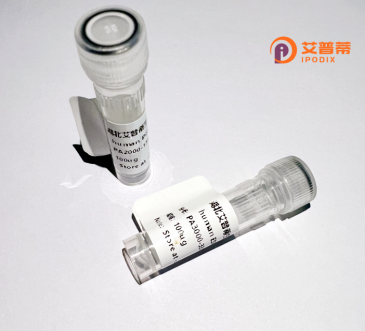
| 纯度 | >90%SDS-PAGE. |
| 种属 | Human |
| 靶点 | TOB1 |
| Uniprot No | P50616 |
| 内毒素 | < 0.01EU/μg |
| 表达宿主 | E.coli |
| 表达区间 | 1-345 aa |
| 活性数据 | MQLEIQVALN FIISYLYNKL PRRRVNIFGE ELERLLKKKY EGHWYPEKPY KGSGFRCIHI GEKVDPVIEQ ASKESGLDID DVRGNLPQDL SVWIDPFEVS YQIGEKGPVK VLYVDDNNEN GCELDKEIKN SFNPEAQVFM PISDPASSVS SSPSPPFGHS AAVSPTFMPR STQPLTFTTA TFAATKFGST KMKNSGRSNK VARTSPINLG LNVNDLLKQK AISSSMHSLY GLGLGSQQQP QQQQQPAQPP PPPPPPQQQQ QQKTSALSPN AKEFIFPNMQ GQGSSTNGMF PGDSPLNLSP LQYSNAFDVF AAYGGLNEKS FVDGLNFSLN NMQYSNQQFQ PVMAN |
| 分子量 | 38.1 kDa |
| 蛋白标签 | His tag N-Terminus |
| 缓冲液 | PBS, pH7.4, containing 0.01% SKL, 1mM DTT, 5% Trehalose and Proclin300. |
| 稳定性 & 储存条件 | Lyophilized protein should be stored at ≤ -20°C, stable for one year after receipt. Reconstituted protein solution can be stored at 2-8°C for 2-7 days. Aliquots of reconstituted samples are stable at ≤ -20°C for 3 months. |
| 复溶 | Always centrifuge tubes before opening.Do not mix by vortex or pipetting. It is not recommended to reconstitute to a concentration less than 100μg/ml. Dissolve the lyophilized protein in distilled water. Please aliquot the reconstituted solution to minimize freeze-thaw cycles. |
以下是关于TOB1蛋白的3篇代表性文献及其摘要简述:
1. **"Tob1 regulates Treg cell function through metabolic adaptation to the tumor microenvironment"**
*作者:Li X et al.*
摘要:研究发现TOB1通过调控调节性T细胞(Treg)的线粒体代谢重编程,影响其在肿瘤微环境中的免疫抑制功能,提示其在肿瘤免疫逃逸中的作用。
2. **"Structural insights into the mechanism of TOB1-mediated mRNA decay suppression"**
*作者:Wang Q et al.*
摘要:通过X射线晶体学解析TOB1蛋白与mRNA结合的结构,揭示其通过阻止脱腺苷酸化酶(CCR4-NOT复合体)募集来抑制mRNA降解的分子机制。
3. **"TOB1 deficiency promotes gastric cancer progression via ERK signaling activation"**
*作者:Chen J et al.*
摘要:发现TOB1在胃癌中低表达,其缺失通过激活ERK/MAPK通路促进癌细胞增殖和转移,提示其作为肿瘤抑制因子的潜在治疗价值。
Tob1 (Transducer of ERBB2) is a member of the TOB/BTG protein family, known for its role in regulating cell cycle progression and cellular differentiation. Initially identified as a tumor suppressor, Tob1 functions as a transcriptional regulator that interacts with components of the CCR4-NOT deadenylase complex, such as CAF1. to modulate mRNA stability and translation. Structurally, it contains a conserved N-terminal BTG domain critical for protein-protein interactions and a C-terminal region involved in RNA binding.
Tob1 is expressed in various tissues, including the brain, heart, and immune cells, and its activity is regulated by phosphorylation. Studies highlight its involvement in suppressing T-cell activation, maintaining immune homeostasis, and inhibiting cancer cell proliferation by blocking G1-S phase transition. Dysregulation of Tob1 is linked to malignancies, autoimmune disorders, and developmental defects.
Recombinant human Tob1 protein is engineered using bacterial or mammalian expression systems for functional studies. Its applications span cancer research, drug screening, and mechanistic studies of post-transcriptional gene regulation. Challenges in production include optimizing solubility and post-translational modifications for accurate biological activity. Current research explores its therapeutic potential as a target for immunomodulation or anti-cancer strategies.
×